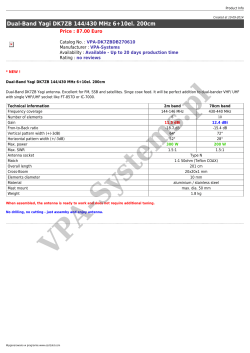
GSM Network Architecture ELET 6302
GSM Network Architecture ELET 6302 Motivation Outline Introduction and history. GSM architecture. Implementation. Technology and standards. Summary Introduction Global System for Mobile Communication (GSM) Anybody – 500 million users (may 2001) Anywhere – 168 countries (may 2001) Any media – voice, messaging, data, multimedia Source: Hillebrand, 1 GSM Architecture Home Location Register BTS = Base Transceiver Station AuC Network Management Center AuC = Authentication Center OMC = Operation and Maintenance Center Equipment ID PSTN = Public Switched Telephone Network ME = Mobile Equipment Subscriber Identity Module ME B T S Subscriber Identity Module ME B T S Subscriber Identity Module ME B T S Visitor Location Register Mobile switching center Base station controller OMC Data communication network PSTN Source: Stallings, 313 Source: Mehrotra, 27 GSM Architecture MS Transmission Band : 890 – 915 MHZ BS Transmission Band : 935 – 960 MHZ 45 MHz F1 F2 F1' F2' 1 2 3 4 5 6 7 8 Year Introduced 1990 Access method TDMA Channel Bandwidth 200 kHz Number of duplex channels 125 Users per channel 8 Speech coding bit rate 13 kbps Data coding bit rate 12 kbps Frame size 4.6 ms Frequency SIM (Subscriber Identity Module) Billions of Calls Millions of Subscribers Thousand of Different Types of Telephones Hundreds of Countries Dozens of Manufacturers…. •Administrative data And only one Card: The SIM •Security data •Subscriber data •Roaming data •PLMN (Public Land Mobile Network Source: Hillebrand, 369 http://ucables.com/products/simcards/ Implementation Receiver >Channel Decoding Voice decoding Deciphering >De-Interleaving Demodulation >Re-formatting >Channel encoding Voice encoding >Interleaving Ciphering Modulation Amplifier >Burst generation Transmitter Central processor, clock and tone, internal bus system, keyboard (HMI) SIM = Subscriber Identity Module Source: Heine, 14 Input filter O&M Module HF Transmitter (HF-TX) HF Receiver (HF-RX) TRX Digital signal processing (NF functionality) Transmission system Output filter Slow frequency hopping Implementation AbisInterface Operation and maintenance functionality/clock distribution Block Diagram of a BTS with one TRX Source: Heine, 20 GSM Variants Variant Uplink (MHz) Downlink (MHz) Total Bandwidth DuplexChannels frequency GSM-400 451-458 and 479-486 461-468 and 489-496 Twice 14 MHz 10 MHz Twice 72 GSM-900 (primary band) 890-915 935-960 Twice 25 MHz 45 MHz Twice 124 Extended GSM-900 880-915 925-960 Twice 35 MHz 45 MHz Twice 174 GSM-R 876-880 921-925 Twice 4 MHz 45 MHz Twice 19 DCS-1800 1,710-1,785 1,805-1,880 Twice 75 MHz 95 MHz Twice 373 PCS-1900 1,850-1,910 1,930-1,990 Twice 60 MHz 80 MHz Twice 300 Source: Bekkers, 299 Summary Network architecture Implementation Voice application Data application References Bekkers, Rudi. Mobile Communications Standards: GSM, UMTS, TETRA, and ERMES. Norwood, MA: Artech House, Inc., 2001. Halonen, Romero, and Melero. GSM, GPRS, and EDGE Performance: Evolution Towards 3G/UMTS. England: John Wiley & Sons Ltd., 2003. Hillebrand, Friedhelm. GSM and UMTS: The Creation of Global Mobile Communications. England: John Wiley & Sons Ltd., 2002. Heine, Gunnar. GSM Networks: Protocols, Terminology, and Implementation. Norwood, MA: Artech House, Inc., 1999. Mehrotra, Asha. GSM System Engineering. Norwood, MA: Artech House, Inc., 1997. Harte, Levine, and Livingston. GSM Superphones. United States: APDG Publishing, Inc. A Division of McGraw-Hill, 1999.
© Copyright 2025





















